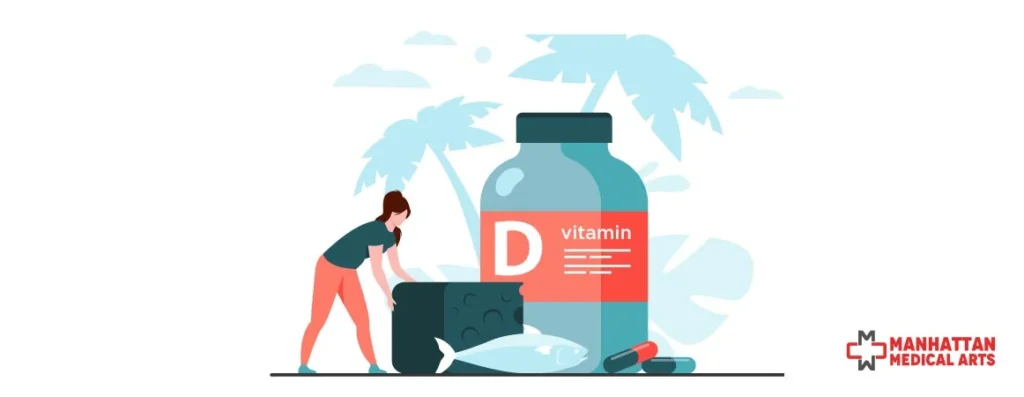Your body needs a proper consumption of nutrients to function. It needs a healthy diet, plenty of fluids, physical activity, and a number of other things that are part of a healthy lifestyle. One of those things is adequate exposure to sunlight. Sunlight provides vitamin D, which is an extremely important micronutrient that helps make bones, muscles, and heart strong, it helps with calcium absorption and makes the immune system function properly. Vitamin D has a few food sources like fish, red meat, egg yolks, and liver. You can also consume vitamin D via sunlight.
If you don’t consume enough vitamin D, you can develop a vitamin D deficiency. It may not seem like a big problem but it can cause serious damage to your health. Vitamin D deficiency is now a global health issue. Around 1 billion people around the world have low levels of vitamin D in their bodies. In the United States, about 42% of the population has vitamin D deficiency.
What is Vitamin D Deficiency?
It is quite self-explanatory, vitamin deficiency is the insufficiency of vitamin D in the body. Vitamin D is a unique micronutrient because the skin can produce it when exposed to sunlight. Vitamin D is essential for strong bones and muscles. 14 signs of vitamin D deficiency are associated with many health problems, one of them being rickets which is a bone disease that happens when the bones do not get enough minerals and start to become soft and brittle. The recommended daily intake of vitamin D for adults is 600 IUs a day, which goes up to 800 IUs a day for people over 70.
Importance of Vitamin D
Vitamin D is extremely important for your body. It helps keep your bones healthy, it aids in calcium absorption, without vitamin D your body can’t absorb calcium as effectively as it should. If your body is unable to absorb calcium due to a lack of vitamin D, you may develop serious bone and joint disorders like osteoporosis, rickets, and more. Calcium is also important for the teeth and muscles.
6 Vitamin D Deficiency Symptoms
Lack of vitamin D in the body is difficult to detect without a vitamin deficiency test, as vitamin D deficiency doesn’t exhibit any obvious signs and symptoms but you may feel and experience some of the following vitamin D deficiency symptoms:
- Weak Bones and Pain in the Body
We already know that vitamin D makes the bones and muscles stronger, so evidently, without it, the bones would grow to become weaker. There are also many studies that have proven that vitamin D deficiency can lead to chronic back pain. It can also cause pain in the legs, joints, and ribs.
- Hair Loss
In women, vitamin D deficiency can also lead to extreme hair loss. A disease called alopecia areata is linked to the lack of vitamin D in the body.
- Teeth Loss
Many researchers have proven that vitamin D deficiency can lead to dental decay. Mainly because, vitamin D helps absorb phosphate and calcium, which are both important for healthy teeth.
- Low immunity
Vitamin D helps the immune system function effectively. Without it, the immune system would grow weak and as a result, you would become more susceptible to getting sick frequently.
- Mood Swings
Vitamin D deficiency just like any other deficiency can affect your mood as well. It’s simple, without the vitamin you’ll experience fatigue as your bone would grow weaker, due to that fatigue you won’t be able to function properly, which will affect your mood and can make you depressed and anxious.
- Inflammation
Vitamin D helps control inflammation in your body. The lack of it would create a stimulus-response that will make the nociceptors send a pain response to your brain, which results in inflammation.
How is Sunshine Related to Vitamin D?
Vitamin D is often referred to as vitamin d sunshine or the sunshine vitamin. The reason is that sunshine is a great source of vitamin D. Your skin can literally produce vitamin D after being exposed to the sun. The 7-dehydrocholesterol in your body interacts with the sun’s ultraviolet B rays, it helps synthesize it and convert it into vitamin D3, which is an active form of vitamin D.
Best Source of Vitamin D to avoid Deficiency
There are multiple vitamin D deficiency causes but the most common one is little to no consumption of vitamin D. Here are some of the best sources of vitamin D that will help you consume your daily fill of this micronutrient:
- Sunshine: The best source of vitamin D3, the active derivative of vitamin D. A regular exposure to sunlight, is the most natural way to consume vitamin D. To maintain a healthy level of it in your body, take a walk outside in the sun during midday for about 10-30 minutes a couple of times in a week. If your skin color is darker, it would take more time for your skin to absorb vitamin D, so you may need to spend a little more time as compared to fair-skinned people. Your exposure to sunlight is also dependent on how sensitive your skin is.
- Fish: Some oily fishes have a high level of vitamin D in them. Salmon is one of the best food sources for vitamin D and according to the USDA, a 100 gram salmon from the Atlantic contains 526 IU of vitamin D.
- Red Meat: There are 34-36 IU of vitamin D3 in 2.5-ounce of cooked beef meat. But the cholesterol levels of red meat are high so it is not recommended to consume red meat every day.
- Egg Yolks: An egg is a highly nutritious food. While the egg white is rich in proteins, the rest of the nutrients like vitamins, fat, and minerals can be found in the egg yolk. One egg yolk contains 37 IU of vitamin D, which is 5% of the DV.
- Fortified Food: There are some food sources that are fortified with vitamin D3. It can be found in cow’s milk, orange juice, soy milk, almond milk, and breakfast cereals.
Low Vitamin D Side Effects and Health Risks
If your body is extremely low on vitamin D, it can be very hazardous for your health. It can lead to serious health problems. Here are some severe vitamin d deficiency symptoms and side effects:
- Loss of Bone Density:
In a vitamin D deficient person the bones would lose their density mainly because of a lack of calcium absorption. One of the vitamin D deficiency symptoms in adults is the development of osteoporosis caused by weak bones. You may also become more prone to fractures and injuries. In children, vitamin d deficiency can cause rickets, which is a rare disease in which the bones become soft and bend.
- Increased risk of cardiovascular disease:
Vitamin D deficiency can affect your cardiac health as well. According to a few studies it can lead to diseases and health problems like hypertension, heart failure, and ischemic heart disease.
- Cancer
There have been a few studies that prove an inverse association between vitamin D levels and breast cancer. Vitamin D deficiency increases the risk of breast cancer in women. There also have been a few documented cases in which the condition was associated with prostate cancer and ovarian cancer as well.
Speak To Us
There may be no evident signs of vitamin D deficiency, so some people may not even know they have this condition until it’s too late. Even if you are a relatively healthy person, get tested to check the levels of vitamin D in your body. Our expert primary care physicians can help you come up with a vitamin D deficiency treatment plan which will entail a diet plan and a few health tips for increasing vitamin D in your body. If you severely lack vitamin D, you might even be given some supplements.
– Disclaimer –
This blog is for informational & educational purposes only, and does not intend to substitute any professional medical advice or consultation. For any health related concerns, please consult with your physician, or call 911.
-
About The Author
Dr. Syra Hanif M.D.Board Certified Primary Care Physician
Dr. Syra Hanif is a board-certified Primary Care Physician (PCP) dedicated to providing compassionate, patient-centered healthcare.
Read More







